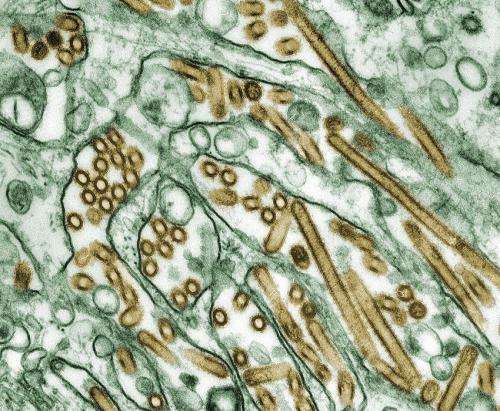Researchers a step closer to understanding how deadly bird flu virus takes hold in humans

New research has taken a step towards understanding how highly pathogenic influenza viruses such as deadly bird flu infect humans.
Researchers at Griffith's Institute for Glycomics and the University of Hong Kong have revealed specific sugar molecules—Sialylated O-glycans—that are present in the respiratory tract are key receptors for influenza viruses, particularly the highly pathogenic influenza virus strains.
In a first, the work, published in Scientific Reports, details the structural basis of highly pathogenic avian influenza viruses that make them particularly susceptible to bind and recognise O-glycans.
Lead researcher Associate Professor Thomas Haselhorst said unlike seasonal influenza, in which infection usually causes only mild symptoms in most people, avian influenza (H5N1) has an unusually aggressive clinical course, with rapid deterioration and high fatality.
"Primary viral pneumonia and multi-organ failure have been common among people who have become ill with H5N1 influenza," Prof Haselhorst said.
"Our finding sheds new light on how deadly influenza viruses attach to cells that are present in the respiratory tract and the importance of O-glycans has been overlooked so far.
"At this stage our research indicates that a specific region in the avian virus protein called haemagglutinin is structurally well suited to recognise and bind these receptors.
"The good news is that bird flu H5N1 avian influenza viruses rarely infects humans and from person to person is rare. However, we still have concerns that the virus could evolve to become more transmissible among humans which could potentially make this deadly virus an extremely serious global public health threat.
"We are currently investigating if the binding event to our newly discovered O-glycans could play a role in such an event.
"With this knowledge we can enter the next phase and develop novel molecules that mimic these identified O-glycans receptors and block virus binding that would ultimately prevent human infection."
Prof von Itzstein, Director of the Institute for Glycomics and co-author on the paper, said this work demonstrates how much we still have to learn about these deadly viruses and the way they can cause infection.
"This study opens new avenues for the development of novel anti-influenza drugs which are desperately needed," he said.
















